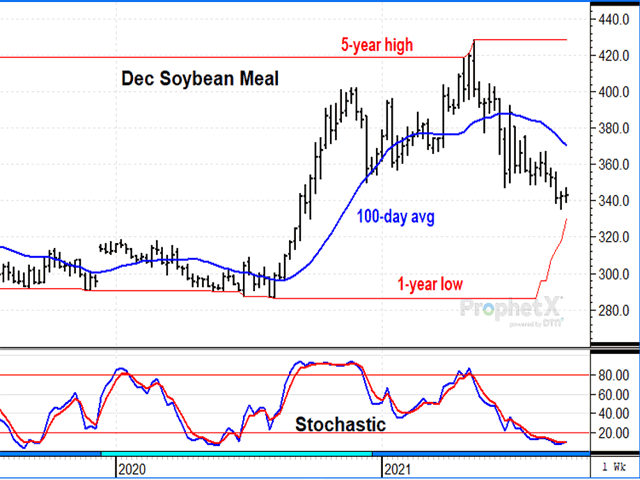Todd's Take
A Case for Support in Soybean Meal
One of the unusual things about the soybean rally of 2020-21 was that it was led primarily by rising soybean oil prices and, more generally, by demand for vegetable oil -- not by soybean meal prices as is the more common case.
It was palm oil that first emerged from the bearishness of the pandemic, making new highs in July 2020, followed by soybean oil making highs in August. A lack of immigrant workers in Malaysia, due to anti-coronavirus restrictions, kept palm oil production limited, even into 2021 as the delta variant spread.
U.S. soybean export sales to China picked up in July 2020 and stayed active until February. Every sale of soybeans tightened the price outlooks for both soybean meal and oil, but oil was the clear demand leader in the market, more than doubling in value after making new highs in July. Spot soybean meal, on the other hand, made new highs in August and increased roughly 50% in value by the time prices peaked in January.
Early in the rally, traders were not sure the upward move in soybeans could be trusted as meal was the more traditional leader, more commonly pushing crush activity higher and leaving behind a surplus of soybean oil. The past year proved soybean oil too can lead a big rally in soybean prices.
Even though soybean meal prices were not rising as fast as soybean oil early in 2021, it looked like there was enough bullishness in soybeans' tight supply situation to accommodate higher prices of both soybean meal and oil. That changed after December soybean meal peaked at $428.50 on May 12. Since then, meal prices gradually chopped lower, falling 22% and hitting a 10-month low of $335.40 on Sept. 9.
P[L1] D[0x0] M[300x250] OOP[F] ADUNIT[] T[]
The unexpected weakness in meal prices seemed a bit harsh, considering soybeans are in line to end 2020-21 with the tightest stocks in seven years. In hindsight, it looks as if crushers dealt with the expectation of fewer soybeans this summer by crushing more earlier in the year. As it worked out, there was enough meal to comfortably finish the summer without end users having to scramble for supplies.
Fundamentally, buyers of soybean meal for feed shouldn't let the price weakness of the past four months in meal deceive them into thinking all is well, as soybean supplies are expected to remain tight in 2021-22. China will have a large say in just how tight the market gets. Early in the new season, demand looks strong with November soybeans on the Dalian exchange trading at their highest prices in 2021.
Technically speaking, December soybean meal peaked out in May, near its highest prices in five years, and now has fallen back, near its lowest prices in one year. The short-term trend remains down, but it is quite possible prices could find support in this area near the $335.40 low.
As bullish as the outlook for soybean prices currently looks, one person at Husker Harvest Days in Grand Island, Nebraska, asked on Tuesday: "What happens if African swine fever (ASF) turns up in the U.S.?"
Well, that would obviously not be good news for grain prices, especially soybean meal. For traders, there are the usual risks in going long soybean meal at current prices. But for users of meal as a feed, this may be a good place to secure future needs, if you haven't done so already.
There may very well be unexpected twists and turns in the season ahead and, yes, ASF is one of the risks. The more likely scenario at this point, however, is that U.S. soybean supplies will remain historically tight again in 2021-22, and that includes supplies of soybean meal.
Join us at this year's DTN Ag Summit in Chicago on Dec. 5 to 7, our annual event with several learning opportunities to choose from. Find out more and register at www.dtn.com/dtn-ag-summit/ .
**
Comments above are for educational purposes only and are not meant as specific trade recommendations. The buying and selling of grain or grain futures or options involve substantial risk and are not suitable for everyone.
Todd Hultman can be reached at Todd.Hultman@dtn.com
Follow him on Twitter @ToddHultman1
(c) Copyright 2021 DTN, LLC. All rights reserved.




